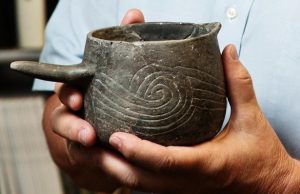Everyone knows that coffee and tea contain caffeine. But many people are unaware that a number of other plants used to make beverages also deliver the precious drug. An example is the drink brewed from the leaves and brances of yaupon holly, a variety of maté. Recently, residues on pottery cups prove that, by around 1000 AD, residents of the pre-Columbian site of Cahokia, a city near what is now St. Louis and resident to 50,000 people, made a strong drink from this shrub. The discovery represents the oldest use of the so-called “Black Drink” in North America.

Cahokia, near the confluence of the Missouri and Mississippi Rivers, was at it’s height around 1000 AD but abandoned by the 1300’s. When the Spanish arrived in the Americas, they reported that natives in the southern areas were drinking a beverage the Spanish called “Black Drink,” a dark tea made from the dried, roasted leaves of the Yaupon holly (Ilex vomitoria). This drink was loaded with caffeine!
The native Americans used it for stimulation and, because, it causes vomiting when consumed rapidly in large quantities, employed it in their purification rituals. Because the plant only grows hundreds of miles south of Cahokia, the discovery of Black Drink residue proves that trade was active throughout this wide region.

A team from the University of New Mexico studied eight beakers from sites around Cahokia, dating from AD 1050 to AD 1250. The beakers, which resemble coffee mugs, are single-serving containers with a handle on one side and a small lip on the other. Many were carved with symbols representing water and the underworld. All of the beakers contained traces of caffeine.
These findings were reported in the Proceedings of the National Academy of Sciences, Patricia L. Crown, “Ritual Black Drink Consumption at Cahokia.”



